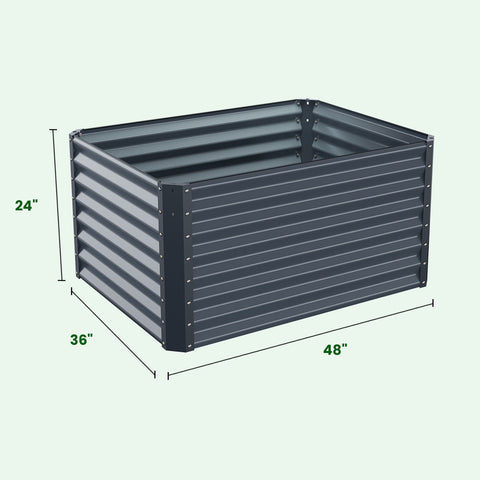If you're an avid tomato grower like me, you've most likely had to deal with tomato suckers at some point. These are tricky little things, and I'm really struggling with whether to leave them the same or cut them off.The following content also has some reference value for raised garden beds.
Luckily, I'm going to give you a few tips and tricks that will help prevent you from going through the same confusing experience.

But, before we get to the good stuff, let's discuss what those things actually are.
What are tomato suckers?
Simply put, a tomato sucker is essentially a small bud that begins to grow where the branch and stem of a tomato meet.
If the tomato suckers are not affected, they will grow larger branches and become trailing, bushy tomato plants. This is one of the main reasons why removing tomato suckers is so common, as many owners don't like the growth.
Eventually, they may even start growing their own fruit. However, there are pros and cons to removing them as well as keeping them, and it's important to think carefully about this decision in order to do what's best for your garden.
Luckily, at the end of the day, you don't have to worry about tomato suckers causing so much damage that they'll kill your tomato plants. But, now that you know exactly what tomato suckers are, you can start making personal decisions about whether to continue to let them grow in your garden.

What are the benefits of pruning tomato suckers?
When you talk to someone about whether or not to prune your tomato suckers, the most common argument in favor of this action is that doing so will allow you to have larger, higher-quality fruit.
While tomato suckers may begin to grow their own fruit, they will compete with the rest of the plant for nutrients by doing so. This means that as the amount of fruit a plant produces increases, the size and quality of the fruit decreases. Many gardeners would rather have a small amount of high-quality fruit than a large amount of low-quality fruit, but each has his or her own passions.
Is it a good idea to trim your tomato suckers?
Pruning your tomato suckers is not mandatory. A lot of gardeners don't do that, and their plants end up doing just fine.
The main thing you have to consider when making this decision is the type of tomato plant you are dealing with. I'm now going to introduce some of the best pruning plants.
When Should you trim tomato suckers
There are two types of tomatoes: indeterminate and deterministic. Iffy plants tend to get very large and bloom all season, which means they definitely need regular pruning. Left to their own devices, these idiots become disobedient and begin to spin out of control. However, if you remove the suckers completely, your total tomato production may decrease. My years of gardening have taught me that it's all about finding the perfect balance.

A good rule of thumb is to always leave 2-3 suckers on the plant. If they start to grow more, simply prune them.
Every gardener has their own way of pruning plants, and it's up to you to figure out the best way. Start with just a little pruning and work your way up from there until you find the technique that works best for your garden.
If you choose to prune your tomato suckers, here are some super awesome benefits you'll experience:
- Earlier production. When you cut the suckers, the tomato uses less energy to grow and more energy to produce fruit. This means your tomatoes will grow faster, and I'm personally a big fan.
- Bigger and healthier fruits. The fewer branches a tomato plant has, the less competition there is between the fruits for nutrients. That means big, healthy, delicious tomatoes -- basically every gardener's dream.
- Disease prevention. The more tomatoes there are on a plant, the heavier it will be. This usually means that tomatoes are closer to the ground and therefore more likely to soak in water and grow mold, bacteria and fungi. Not very appetizing, is it?
When you're not supposed to trim your tomato suckers

Despite these cool benefits, you don't always have to trim your tomato suckers, especially if you have firm tomato plants.
Firm tomatoes are usually firm, which means they don't need pruning. Once they reach a certain size, they stop growing. And the fruit comes out all at once and won't grow after pruning, so pruning is a waste of time.
These types of tomatoes are not common, but it's still important to have this information on hand.
How and When to trim tomato suckers
If you do have tomato plants you are unsure about, here is how you should prune them.
Start pruning tomato suckers when they are small and fragile, rather than when they are mature and strong. Using your fingers instead of scissors, grab the sucker from the bottom. Bend back and forth until it comes off completely.
This method is good because your hands cause less damage than scissors, which means the plant will heal faster. The faster the plant heals, the less chance of infection or illness. If you have to wait until the suckers are old to trim, you may have to use scissors. Do it as gently as possible and be sure to sterilize it.
Recommended :Vivosun Pruning shears
Finally, a few things to remember

Now that you know the basics of pruning tomato suckers, here are what I think are the most important tips to keep in mind
- Don't over-prune, especially if you live in a hot climate. If you do, the hot sun can seriously damage your plants.
- If you decide to prune tomatoes, do so sparingly. They usually don't need pruning, and you don't want to negatively affect your tomato production
- However, always prune tomatoes you are unsure about. In order to grow healthy tomatoes, they need pruning, and if you leave them to their own devices, they will become big and wild.
- Always use the best judgment. At the end of the day, they are your tomato plants and you should know them like the back of your hand.
That's all you need to know about how to prune tomato suckers!










Comments
Judi said:
Good article, just maybe consider supporting photos be of the plant you are talking about.